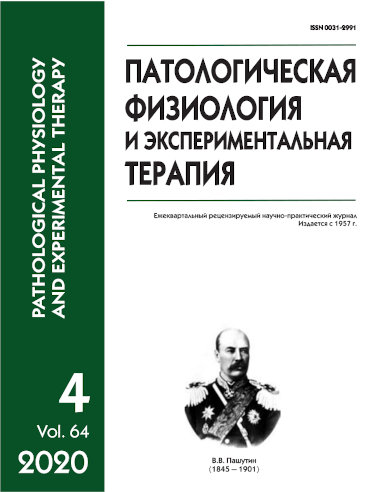Differentiation of blood monocytes and features of the cytokine status in patients with lung tuberculosis
DOI:
https://doi.org/10.25557/0031-2991.2020.04.79-87Keywords:
pulmonary tuberculosis, cells, monocyte, macrophage, cytokines, flow cytometry, enzyme immunoassay, monocyte differentiationAbstract
In clinical manifestation of pulmonary tuberculosis, alveolar macrophages perform as a reservoir where they accumulate mycobacteria and lose their effector functions due to the pathological conversion of macrophage pro-inflammatory M1 phenotype to the anti-inflammatory M2 phenotype, which provides transition to chronic infection. The study hypothesis suggested that the cytokine status, as evaluated by leukocyte secretion of cytokines in vitro, influences the monocyte polarization in the blood during their migration to the inflammatory focus, thereby determining differentiation and pathways of macrophage activation in tissues.The aim of this work was to assess the immunophenotype of blood monocytes and the in vitro secretion of immunoregulatory cytokines by mononuclear peripheral blood leukocytes from patients with different clinical forms of pulmonary tuberculosis taking into account the pathogen sensitivity to major anti-tuberculosis drugs.Methods. 65 patients with newly diagnosed pulmonary tuberculosis were evaluated. The study material was venous blood and peripheral blood mononuclear leukocytes. Monocyte immunophenotype was determined in whole blood by flow cytometry on a Cytoflex flow cytometer (Becman Coulter, USA) with monoclonal antibodies (eBioscience, USA). Results were processed with a CytExpert 2.0 software. The number of cells expressing surface markers, CD14, CD163, CD204 and HLA-DR, was determined. Content of cytokines (IL-2, IL-10, TGFβ) in supernatants of cell cultures was measured by enzyme-linked immunosorbent assay (ELISA). Results of the study were processed with a SPSS v.11.0 standard software package.Results. The study results suggested that with an overall decrease in the number of circulating CD14-positive blood monocytes in patients with pulmonary tuberculosis regardless of its clinical form, high expression of cell activation markers remained both for the pro-inflammatory M1 phenotype (HLA-DR-positive monocytes) and the anti-inflammatory M2 phenotype (CD163-positive monocytes). In disseminated tuberculosis, the number of anti-inflammatory CD204-positive monocytes, M2 macrophage precursors, increases indicating predomination of the immunosuppressive response. In vitro analysis of the cytokine status showed that tuberculosis progression is accompanied by inhibition of effector immune responses and increases in anti-inflammatory cytokine concentrations in vitro. These changes may be equally either a cause or a consequence of deficient IL-2 secretion. We also found that the secretion of mediators with suppressor effects (IL-10, TGFβ) varied depending on both the clinical form of tuberculosis and the pathogen sensitivity to anti-TB drugs; IL-10 hypersecretion was observed in patients with drug-sensitive, infiltrative tuberculosis whereas TGFβ hypersecretion was observed in disseminated, drug-resistant tuberculosis.Conclusion. Features of blood monocyte differentiation in patients with pulmonary tuberculosis allowed us to conclude that monocytes, the macrophage precursors, start expressing markers for different functions of M1 and M2 macrophages with polarization toward the M2 immunophenotype already in the bloodstream. Therefore, in the development of pulmonary tuberculosis, cytokine regulation mechanisms become involved in suppressing the activation of innate immunity, which possibly causes chronic inflammation in the lungs and formation of Mtb-induced immunodeficiency.Downloads
Published
2020-11-26
Issue
Section
Original research
How to Cite
[1]
2020. Differentiation of blood monocytes and features of the cytokine status in patients with lung tuberculosis. Patologicheskaya Fiziologiya i Eksperimental’naya Terapiya (Pathological physiology and experimental therapy). 64, 4 (Nov. 2020), 79–87. DOI:https://doi.org/10.25557/0031-2991.2020.04.79-87.






